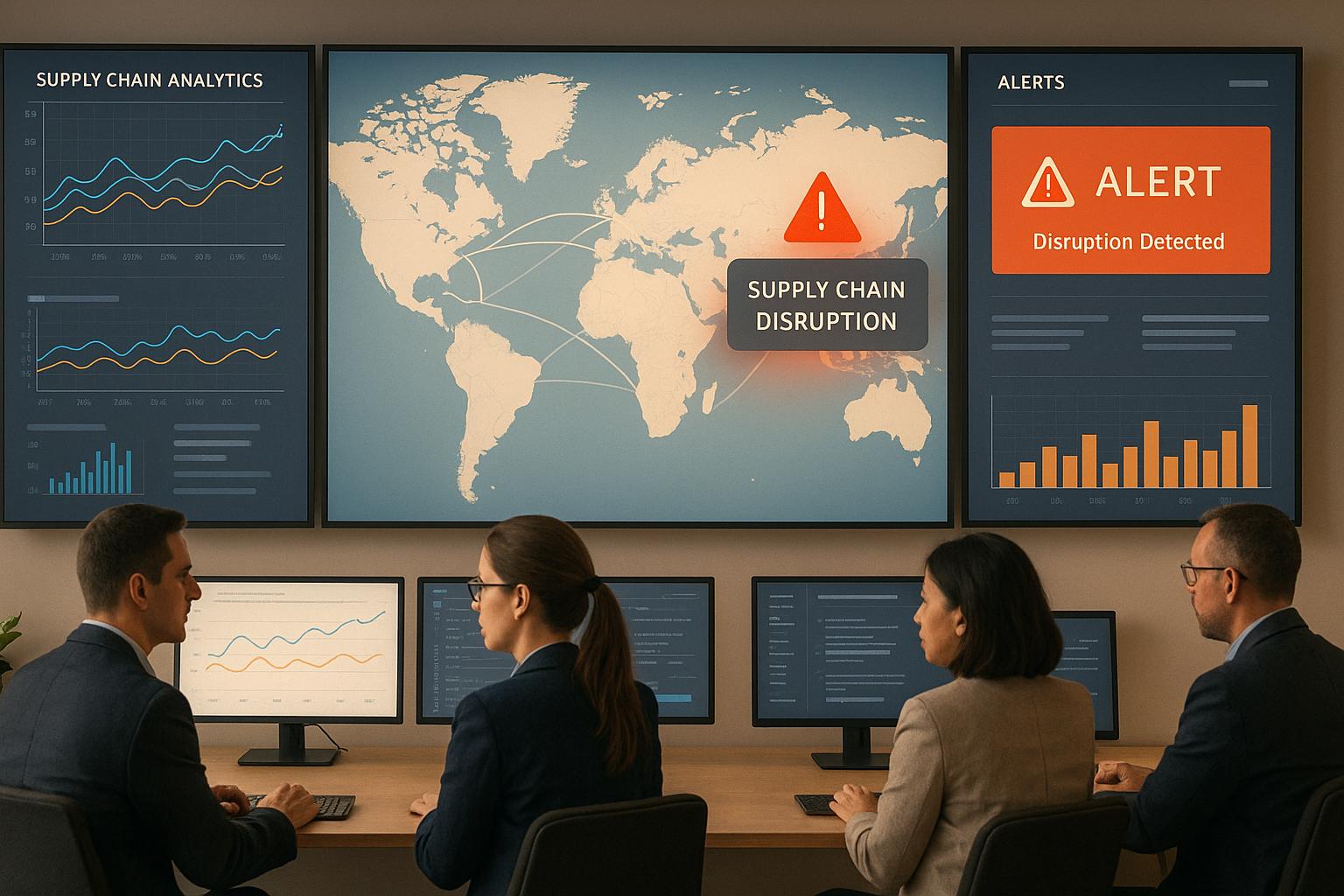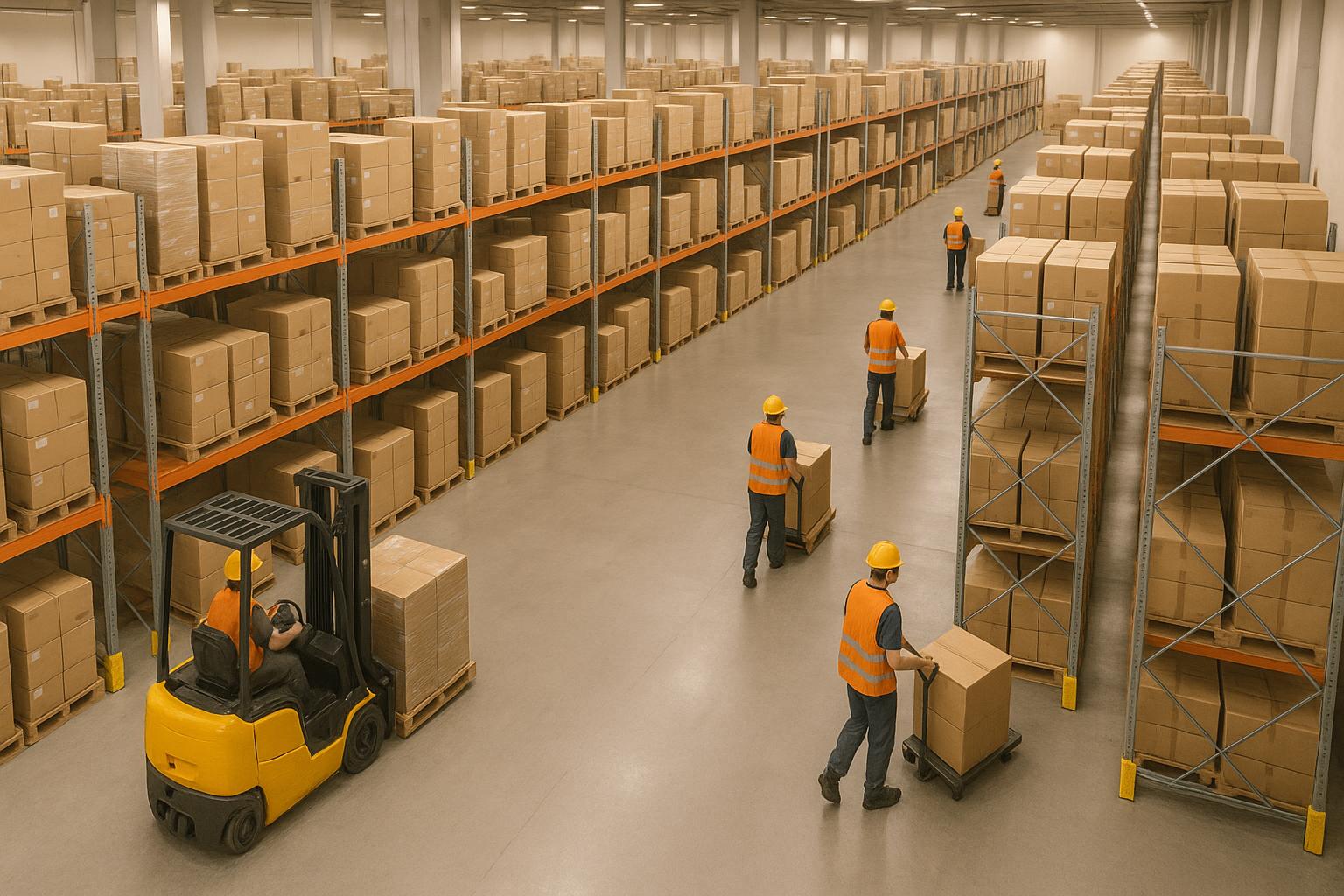Real-Time Alerts for Supply Chain Disruptions

Supply chain disruptions cost U.S. businesses billions annually, stemming from delays, supplier issues, and customs bottlenecks. Real-time alerts offer a solution by providing immediate notifications of problems, enabling companies to act fast and prevent minor issues from escalating into major disruptions.
Here’s how real-time alerts help businesses:
- Monitor transportation delays: Get instant updates on weather, traffic, or mechanical issues affecting shipments.
- Track supplier performance: Detect production delays, quality problems, or financial risks early.
- Manage customs challenges: Identify documentation errors, port congestion, or inspection delays in real time.
- Automate responses: Use AI to predict issues and trigger actions like rerouting shipments or notifying customers.
AI-Powered Custom Alerts in Supply Chain | Proactive Risk Management with SAP

Supply Chain Problems Real-Time Alerts Can Detect
Real-time alert systems are a game changer when it comes to spotting supply chain issues before they spiral out of control. They track your entire network, keeping an eye on transportation, supplier performance, and even regulatory hurdles. Knowing the kinds of disruptions these systems can catch is crucial for tackling today’s most common supply chain challenges.
Transportation and Shipping Delays
Shipping delays are a constant headache for businesses, often leading to higher costs and unhappy customers. Real-time alerts give you the heads-up when shipments veer off course or run behind schedule, giving you the chance to act fast.
Take weather-related disruptions, for instance. Across the U.S., winter storms can shut down major highways, leaving freight stuck for days. Real-time alerts can pinpoint shipments affected by these conditions and even suggest alternate routes or notify customers of delays. Similarly, during hurricane season, ports like Houston and New Orleans may shut down, creating bottlenecks. These systems help you stay ahead of such challenges.
Another common issue is traffic congestion and road closures. Whether it’s routine traffic or major infrastructure projects like the I-95 improvements, delays can pile up quickly. Real-time systems track these developments and notify you so you can reroute deliveries or adjust schedules.
Then there are mechanical breakdowns and driver-related issues. For example, if a truck breaks down in a remote area or a driver hits their federally mandated hours-of-service limit, real-time alerts notify dispatch teams immediately. This allows them to send a replacement vehicle or driver without wasting time.
By catching these problems early, real-time alerts help keep transportation networks running smoothly.
Supplier Performance Problems
While transportation issues slow down movement, supplier performance problems can disrupt your production lines and hurt product quality. Real-time alerts monitor supplier operations, flagging potential issues before they impact your business.
For example, production delays and capacity issues are common triggers for alerts. If a supplier falls behind schedule or has equipment problems, these systems detect changes in their output and shipping patterns. This gives you time to activate backup suppliers or adjust your production timelines.
Another critical area is quality control problems. When defect rates rise or inspections fail, real-time alerts can notify you immediately. This prevents subpar products from entering your inventory and reaching customers.
Raw material shortages are another red flag. By monitoring suppliers’ procurement activities and inventory levels, real-time systems can spot bottlenecks early. If your supplier is struggling to source materials, you’ll know in time to find alternatives or tweak your product offerings.
Finally, financial instability among suppliers is a serious risk. Real-time alerts can track warning signs like payment delays or changes in credit ratings. Early detection gives you the chance to secure new suppliers before a financial collapse disrupts your operations.
These tools ensure you’re always in the loop when it comes to supplier performance.
Customs and Border Delays
When it comes to international shipments, regulatory delays can create major headaches. Real-time alerts provide much-needed visibility into customs processes, helping you navigate these challenges more efficiently.
Documentation errors are a common cause of delays at customs. Whether it’s missing certificates of origin, incomplete commercial invoices, or wrong tariff classifications, real-time systems flag these issues so you can fix them quickly.
Port congestion is another obstacle, especially at busy entry points like Los Angeles, Long Beach, and New York. Real-time alerts track vessel arrivals, berth availability, and container processing times, giving you accurate estimates for when your goods will clear customs.
Then there are regulatory inspections, which can unexpectedly hold up shipments. Real-time systems monitor inspection progress and keep you updated, so you can adjust delivery timelines and manage customer expectations.
Lastly, tariff and duty changes can complicate customs clearance. Real-time alerts notify you when new rates or classifications affect your shipments, ensuring you have the right documentation to avoid further delays.
These insights help you stay on top of regulatory challenges and keep your supply chain moving.
How Real-Time Alert Systems Work
Real-time alert systems are a game-changer when it comes to preventing supply chain disruptions. By combining advanced technologies, these systems create a robust monitoring network that keeps an eye on every aspect of your operations. Their functionality revolves around three core elements working in harmony.
Data Collection and Monitoring
The foundation of any alert system is its ability to gather vast amounts of data from your entire supply chain. These systems pull information from a variety of sources, including transportation devices (like GPS, ELDs, and IoT sensors), inventory controls (WMS, barcode scanners, RFID), and supplier systems (ERP and EDI). All this is made possible through cloud integration and standardized APIs.
For transportation, telematics systems in delivery vehicles provide real-time updates on location, speed, and diagnostics. Electronic logging devices (ELDs) ensure compliance with driver hours, while carrier management systems confirm pickups and track deliveries.
Inventory monitoring is handled through warehouse management systems that track stock levels and movement. Sensors for temperature and humidity play a crucial role in protecting sensitive items like pharmaceuticals during storage and transit.
Supplier performance data flows in from ERP systems, procurement platforms, and EDI connections, providing insights into order acknowledgments, production schedules, and shipping updates. Even financial data, such as supplier credit reports, is monitored to flag potential risks early.
To make sense of this enormous data stream, modern systems rely on APIs and cloud platforms to standardize and consolidate information from multiple sources into a single, cohesive view.
AI and Machine Learning for Predictions
Once the data is collected, artificial intelligence (AI) and machine learning (ML) step in to analyze it. These tools are what elevate modern alert systems beyond basic monitoring, allowing them to predict issues before they arise.
Machine learning algorithms dig into historical and real-time data to identify anomalies and forecast disruptions. For example, if a supplier who usually ships within 48 hours suddenly takes 72 hours, the system flags this as a potential issue. Similarly, weather prediction tools integrate meteorological data with shipping routes, enabling the system to recommend alternate paths when a storm looms.
Anomaly detection is another powerful feature. It spots subtle trends that humans might overlook, such as a supplier's on-time delivery rate dropping from 95% to 85% over a short period. Risk scoring algorithms then prioritize these alerts based on their potential impact, ensuring critical issues, like delays in delivering essential components, get immediate attention.
These insights don’t just sit in a dashboard - they trigger automated responses, ensuring problems are addressed swiftly and effectively.
Automated Alerts and Response Management
The real magic happens when the system turns its insights into actionable alerts. These alerts are designed to drive immediate action, seamlessly integrating into operational workflows to resolve issues as quickly as possible.
Threshold-based triggers generate alerts when specific metrics go beyond acceptable limits. For instance, if inventory levels fall below a five-day supply, the system notifies the procurement team and suggests expedited shipping options.
To ensure no alert goes unnoticed, notifications are sent through multiple channels, including SMS, email, and instant messaging. If an alert isn’t acknowledged promptly, escalation protocols automatically involve higher-level managers.
What sets modern systems apart is their ability to connect directly with response tools. For example, if a shipment is delayed, the system can update customer delivery estimates, generate quotes for alternative shipping options, and assign tasks in project management software - all automatically.
Automated responses handle routine problems without requiring human input. If a truck breaks down, the system can dispatch a replacement vehicle, inform customers of the delay, and update delivery schedules across all systems.
For more complex issues, decision trees guide the response. If a supplier’s quality drops, the system might place orders with backup suppliers, adjust production timelines, and notify quality control teams - all within minutes.
sbb-itb-eafa320
Benefits of Real-Time Alerts for US Businesses
Real-time alerts are changing the game for US businesses by improving how they handle supply chain hurdles. These advanced systems don't just warn you when something goes wrong - they help you stay ahead of problems, cut costs, and keep customers happy. By acting quickly, businesses can turn potential setbacks into opportunities for smoother operations and better performance.
Preventing Problems from Escalating
Real-time alerts catch issues early, giving teams the chance to act before small hiccups become major disruptions. For example, these alerts can flag temperature changes, supplier delays, or unexpected spikes in shipping demand. This early warning system lets businesses reroute shipments, secure backups, or adjust plans in real time.
During busy shipping seasons, these alerts are especially useful. They provide enough notice to arrange alternative shipping options, avoid skyrocketing costs, and stick to delivery timelines, even under tough conditions.
Smoother Operations and Greater Adaptability
By highlighting potential inventory shortages or carrier delays, real-time alerts make it easier to adjust schedules and shift loads as needed. For manufacturing, this means production teams can tweak their schedules to avoid downtime caused by late deliveries of essential components, keeping operations on track.
Customer service also benefits. When delays are flagged early, representatives can proactively communicate with customers, offering updates or alternative solutions to maintain trust and satisfaction.
Cutting Costs and Boosting Efficiency
Early warnings translate directly into savings. Businesses can avoid costly emergency shipping, improve inventory planning to reduce storage expenses, and streamline labor through automation. With better inventory management, companies can operate with leaner stock levels, which not only lowers warehouse costs but also frees up cash flow.
Fewer disruptions mean customer service teams spend less time resolving issues, and administrative tasks like compliance checks and reporting become less of a headache. In short, real-time alerts help businesses run more efficiently while reducing waste and unnecessary expenses.
These systems give US businesses a stronger, more adaptable supply chain, turning potential challenges into opportunities to save money and improve operations.
JIT Transportation's Real-Time Supply Chain Solutions

JIT Transportation blends cutting-edge technology with 3PL services to help U.S. businesses tackle supply chain challenges as they happen. By offering greater visibility and adaptability, their approach enables companies to respond to issues quickly and efficiently. These features align seamlessly with the broader supply chain monitoring strategies previously discussed.
Custom Alerts for Better Supply Chain Oversight
JIT Transportation's systems are designed to keep a constant watch over logistics operations across their nationwide network. They provide updates that highlight potential problems, ensuring quick action. Thanks to integrated ERP systems, these updates are fed directly into existing business platforms, delivering alerts through email, SMS, or dashboards. Their strategically placed facilities enable end-to-end visibility, from the moment goods are received to their final delivery.
Services to Handle Disruptions
In addition to real-time alerts, JIT Transportation strengthens supply chain reliability with a range of tailored services. Their pick & pack and kitting & assembly options allow businesses to adjust order processing and product configurations on the fly. For sensitive or high-value items, white glove handling ensures extra care throughout the process.
Other offerings, like upgrade testing services, help companies modify product specifications when supply chain bottlenecks arise. Their vendor-managed inventory (VMI) programs simplify stock replenishment, while returns management (RMA) ensures sellable inventory is recovered quickly and efficiently.
Nationwide Reach and Scalable Solutions
With a vast carrier network and adaptable infrastructure, JIT Transportation provides multiple shipping options to keep deliveries on schedule - even during disruptions. Their scalable systems handle shifts in demand, enabling expedited orders and inventory rerouting when needed.
Additionally, pooled distribution helps reduce shipping costs while improving overall efficiency. Together, these solutions ensure businesses can maintain reliable and responsive supply chain operations, no matter the circumstances.
Building a Stronger Supply Chain with Real-Time Alerts
A proactive supply chain strategy thrives on the power of real-time alerts, helping businesses tackle disruptions head-on while boosting overall resilience. The ability to quickly identify issues - be it a minor delay or a looming crisis - gives companies the clarity and speed they need to mitigate potential impacts. This swift response capability is what keeps small problems from snowballing into major operational breakdowns.
Real-time monitoring systems are invaluable for spotting transportation delays, supplier setbacks, or customs bottlenecks before they spiral out of control. By catching these issues early, businesses can protect customer relationships and avoid the high costs associated with last-minute fixes. Such an approach not only reduces emergency expenses but also ensures a smoother, more reliable supply chain - an undeniable competitive advantage.
Modern supply chains also benefit from AI-driven systems that send instant, automated alerts packed with critical information. But technology alone isn’t enough. The most resilient supply chains pair predictive technology with adaptable logistics partnerships. These partnerships enable quick rerouting of shipments, dynamic inventory adjustments, and scalable operations - all in real time. Together, this blend of visibility and flexibility creates supply chains that can adapt under pressure without collapsing. When predictive tools are integrated with agile collaborations, real-time alerts shift from being just warnings to becoming strategic assets.
For businesses aiming to enhance their supply chain resilience, JIT Transportation offers a powerful solution. Their real-time monitoring tools and responsive logistics services combine cutting-edge technology with operational adaptability. This integrated approach helps companies stay ahead of potential disruptions rather than scrambling to react after the fact, ensuring a more proactive and robust supply chain framework.
The benefits of real-time alerts are clear: lower emergency shipping costs, happier customers, and stronger supplier reliability. As supply chains grow more intricate, businesses that embrace proactive monitoring and flexible logistics partnerships will be better positioned to thrive in an unpredictable marketplace.
FAQs
How do real-time alerts work with supply chain management systems?
Real-time alerts work effortlessly with supply chain management systems by leveraging IoT devices and advanced logistics software. These technologies gather and share live data, delivering immediate updates about shipment status, location, and any potential delays.
Notifications are sent straight to smartphones, dashboards, or other connected devices, giving stakeholders the ability to keep a close eye on operations and address disruptions as they happen. This instant access to information not only streamlines decision-making but also boosts transparency and keeps supply chain processes running smoothly.
How do AI and machine learning help predict supply chain disruptions?
AI and machine learning are reshaping supply chain management by spotting potential issues before they escalate. These tools sift through massive amounts of historical and real-time data to predict risks like supplier delays, inventory gaps, or even external influences such as weather disruptions or geopolitical events.
By catching these warning signs early, businesses can respond quickly to minimize risks, keeping operations on track and supply chains more resilient. This forward-thinking strategy helps companies navigate challenges and maintain efficiency in a constantly shifting landscape.
How can businesses set up real-time alerts to address their specific supply chain challenges?
Businesses can customize real-time alerts to fit their specific supply chain requirements by setting triggers like shipment delays, inventory shortages, or temperature changes. These alerts can be fine-tuned to highlight critical events and deliver timely updates, helping teams respond quickly to disruptions.
By incorporating advanced analytics and automated communication tools, companies can take this a step further. These tools enable businesses to adjust alert settings over time, aligning them with shifting operational priorities. This proactive strategy helps cut down delays, mitigate risks, and keep supply chain operations running smoothly.
Related Blog Posts
Related Articles

How to Track Reverse Logistics Metrics

Best Practices for Renewable Energy in 3PL Operations

